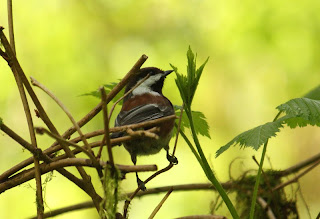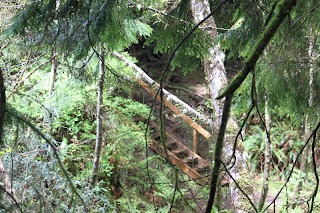Looking for the Lagoon trailhead, we were confused by the signs and finally parked in an area marked "Stagecoach Trailhead" to try to figure out where the Lagoon Trail was. It turns out that the Stagecoach is the trailhead for three trails, including both Waxmyrtle and Lagoon. We later discovered another trailhead in the Lagoon campgrounds.
The trail loops around an oxbow of the Siltcoos River, where lush vegetation provides habitat for a variety of birds and reptiles.
The trail starts with a boardwalk across the water, with a viewing area.
We searched in vain for American Bittern and Green Herons, who must surely love the tall marshy grass. We heard what sounded a bit like a dog barking, until a GREAT BLUE HERON flew out from the grass and we recognized the rough call.
Walking past the boardwalk into the woods, we could see the adjacent, nearly empty campground. Probably a busy place in warmer weather.
 |
| Rufous Hummingbird |
Several RUFOUS HUMMINGBIRDS zipped between the trees between the campground and the trail. One brightly colored male paused for a moment in a large fir tree.
 |
| Wrentit |
We were greeted noisily by an irate WRENTIT, who stuck close by our heads for quite awhile, perhaps until we were well out of range of his chosen nesting place?
 |
| Wrentit |
 |
| Red Legged Frog |
Signs along the trail provided information about the changing habitat and its residents, one of them being the RED LEGGED FROG. Sharp eyes spotted one in the leaves by the trail.
The river vegetation changed as we neared the peak of the oxbow. We could hear the songbirds in the shrubs across the water, but spotted very few. An OSPREY flying overhead may have encouraged them to stay well hidden.
As we headed back to our car, movement in the top of a large tree caught our eye, where a pair of RED CROSSBILLS were perched. The female stayed hidden, but the male peered out from the very top.
 |
| Red Crossbill |
The Siltcoos Recreation Area is a fee area, with both day-use and camping. The recreational vehicle areas are well removed from the wildlife refuge areas, allowing both to co-exist in relative harmony. For the three trails, plan to park at the Stagecoach Trailhead. The Waxmyrtle Trail winds through the estuary and loops to the beach. The Chief Tsiltcoos Trail loops through forest and sand dunes, taking you either to the Driftwood Campground or looping back to your car.
If you plan to spend time in the Florence area, plan to get an Oregon Coast Passport or similar pass, as many of the sites have fees. Ours paid for itself the first weekend!













































